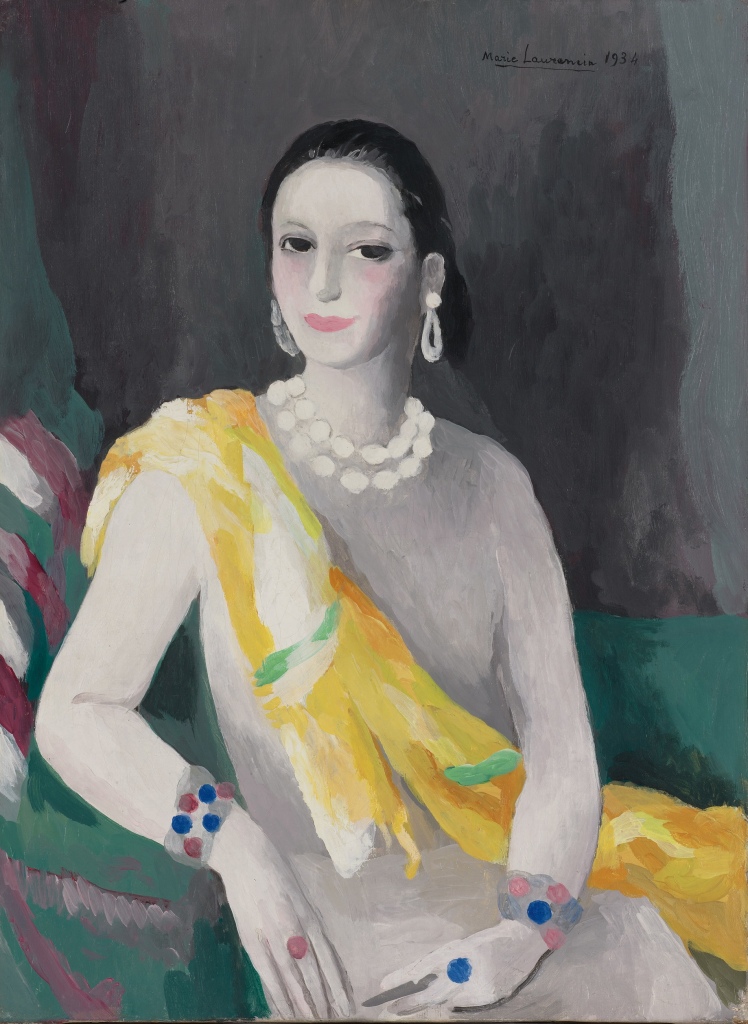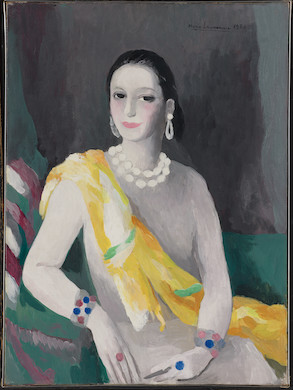Marie Laurencin, Portrait of Helena Rubinstein (Portrait de Helena Rubinstein) (1934); courtesy Private collection, Stowe, Vermont.
* * *
“Presentism” is a term that has taken on new vitality in recent years. The Oxford English Dictionary cites 1916 as its first published usage in the sense that we now know the word—that is to say, the judgment or interpretation of past events, people, or works of art according to contemporary standards. We’ve all read or heard about instances in which historical figures have been deemed dubious, villainous, or worthy of censure when considered under the (ahem) elevated mores of twenty-first-century elite culture. Titian encourages rape, Frederick Douglass is a white supremacist, and John Wayne was—can you just imagine it?—a Republican. We know the routine. But is there an equal-and-opposite theory that imagines historical figures pondering how future audiences might consider their pursuits? This endeavor is, of course, an intellectual lark or, as a colleague has it, a stoner’s question. But there I was, visiting the Barnes Foundation, engaging in some “forwardism” by wondering what the painter Marie Laurencin (1883–1956) might think of her life and work being heralded under the “queer” rubric.
Which is how the Barnes is promoting “Marie Laurencin: Sapphic Paris,” an overview of one of the many fascinating figures populating the demimonde of early twentieth-century France. We learn upon reading the exhibition wall labels that “the excessive femininity of her art hinted at its queerness.” Writing in the catalogue, Rachel Silveri, a professor of art and art history at the University of Florida, avers that Laurencin’s femininity was “strategically coded, enabling her to achieve success in a masculinist art world while nonetheless picturing nonnormative desires.” The curators Simonetta Fraquelli and Cindy Kang write of Laurencin’s “almost exclusively female aesthetic.” Laurencin did state that the “genius of man intimidates me, I feel perfectly at ease with all that is feminine,” but she also said that “I have only one desire, that my paintings have more importance than my presence.” Fraquelli, Kang, and Silveri press hard on Laurencin’s “presence” to the point where we can’t help but wonder how much they value the paintings as paintings.
Albert Barnes liked Laurencin’s paintings. He placed her among “the best French women painters” and promptly snapped up such pictures as Still Life with Bowl and Fruit (1907), Woman with Muff (1914), and Head (ca. 1921), all of which are on display in the Barnes’s permanent collection. “Sapphic Paris,” the first U.S. retrospective in over thirty years, is sequestered in the suite of galleries adjoining the main body of the foundation. The works on display span close to five decades, roughly from1904 to 1950, but concentrate primarily on the heady days of the Parisian avant-garde. The show is divided into sections with titles such as “Picturing Herself,” “In the Thick of It: Paris Before the War,” and “Women Supporting Women.” Alongside Laurencin’s paintings, drawings, and prints, there are corollary objects and art by André Mare, Jean Metzinger, Francis Picabia, and Max Ernst, but not, oddly, her friends Georges Braque and Pablo Picasso. An integral component of the “bande à Picasso,” Laurencin was famously photographed in the Spaniard’s studio in 1911, striking a pose. Still, she went on to distance herself from Cubism, stating that it “poisoned three years of my life . . . aesthetic problems always make me shiver.”
Marie Laurencin, c. 1912; Via Wikimedia Commons
* * *
Laurencin was born in Paris to Alfred Toulet, a government official, and Pauline-Mélanie Laurencin, a domestic and seamstress. Monsieur Toulet visited and supported the offspring of this extramarital dalliance, but Laurencin was raised, in the main, by her mother. The young woman’s interest in art was evident early on, and she eventually studied at the Académie Humbert, at which she met Braque and the future illustrator and fashion designer Georges Lepape. Around 1907, Laurencin encountered Picasso and was subsequently swept into his orbit. She attended the famous dinner held in honor of “Le Douanier” Rousseau, had her work collected by Gertrude Stein, exhibited paintings in a two-person show with Robert Delaunay, and met Wilhelm de Kostrowitzky, better known to history as Guillaume Apollinaire. Laurencin and Apollinaire begin a long and tumultuous affair. Over the years, she involved herself romantically with a variety of men and women. She spent the war years exiled in Spain with Picabia, Stein, Alice B. Toklas, and Albert Gleizes. Laurencin, you see, had married a German baron.
What Do Young Women Dream Of? (1932) is the title of a scene posited somewhere between Wuthering Heights, Greek myth, and the art deco–inspired illustrations of Laurencin’s former schoolmate Lepape. It’s an emblematic work, with a palette predicated on gray and pink, an overriding mood of arcadian yearning, and attenuated almond-eyed ingenues. Laurencin was as much defined and, in the end, constrained by her stylistic mannerisms as Modigliani. Her streamlined figuration can tend toward picture-book fancies or, as one visitor to the Barnes had it, the “princessy.” The finest canvases are those in which Laurencin bumped up against reality. Portraits of Helena Rubinstein, Coco Chanel, and Juliette Lacaze, the wife of the art dealer Paul Guillaume, benefit from the specificity that accrues from having to achieve a likeness, of conveying bone, muscle, and personality. Not that all of her clients were amused: Chanel rejected her portrait as playing too fast and loose with the facts. Laurencin summarily pegged the fashion icon as “a peasant from Auvergne” and remained friendly with her all the same. This admixture of the acidic and the convivial is evident in even the dreamiest of Laurencin’s tableaux. What might an accounting of the oeuvre look like without the baggage of identity politics? We may have to wait another thirty years to find out.
(c) 2024
This review was originally published in the January 2024 edition of The New Criterion.



